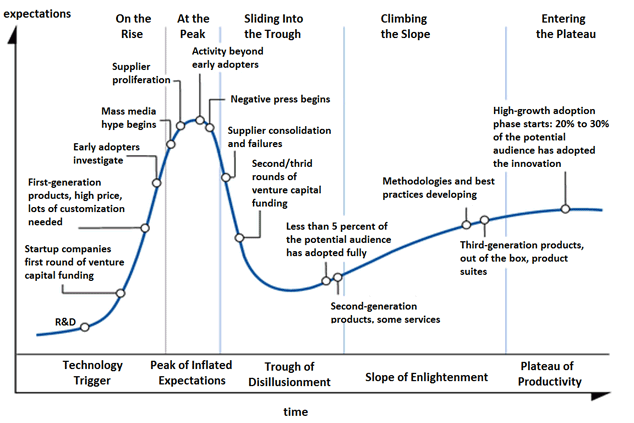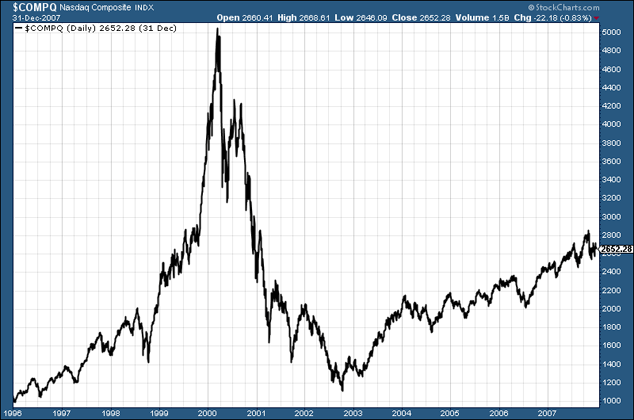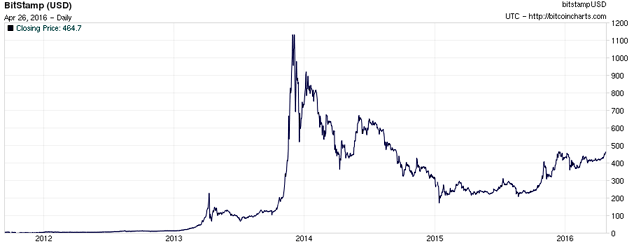Today we’re talking bitcoin, folks.
The bull market is back on, in my opinion.
Here’s why – and what you need to do…
It’s time to buy back into bitcoin
I wrote an entire book about bitcoin in 2014. I was very excited about the possibilities raised by the technology.
Yet I’ve always been rather cautious – bearish even – about bitcoin from an investment point of view. I’ve recommended that you educate yourself about the tech, rather than put significant amounts of capital to work.
I think I was right with the call. When I was writing the book, bitcoin was trading above $500, and it was in a bear market, one in which it remained until late last year. The price ended up falling below $200 a coin.
My outlook, however, has changed. It’s in a bull market now. And I think you should buy in.
There were all sorts of factors that informed my caution, but chief among them was a cycle which research company Gartner has dubbed “the hype cycle”. All new technology seems to go through it.
A simple way to explain it is to look at the rise of the internet and the dotcom boom-bust.
There are so many adjectives we could use to describe the advances we’ve seen since the year 2000. Amazing, breathtaking, mind-blowing – take your pick.
In 2000, only about 350 million people were online. Now it’s more like 3.5 billion. Computers were slow, the internet was slow, Google was only a couple of years old. Facebook didn’t exist, nor did 4G, cloud computing or Gmail. Smartphones? Are you kidding me? Some of us still hadn’t got our first Nokia brick.
Those are some massive changes. And yet the Nasdaq – the US tech stock index – is still trading below its 2000 highs.
How is such a thing even possible? Gartner’s hype cycle explains.
There are five phases. First we have the “technology trigger”. Somebody’s come up with some new tech that piques interest among the few. Some seed money and start-up capital comes in to aid research and development, and we get some first-generation products. Think dotcom in the 1990s.
As the media becomes interested, we move into phase two, “the peak of inflated expectations”. More and more people get excited. This tech is amazing/breathtaking/mind-blowing. It could change the way we operate. Speculative and mainstream money comes in. Share prices start going bananas. Think dotcom in 2000.
That leads to phase three – “the trough of disillusionment”. Prices start to fall, and there’s some negative press as the first-generation products don’t quite match expectation. The realisation dawns that less than 5% of the potential audience has fully adopted. Funding becomes more cautious, and some businesses go under. The thing snowballs into a crash as the speculators rush to get their money out.
Then, with bearish sentiment proliferating, we head into phase four – “the slope of enlightenment”. This is the long, hard slog towards mainstream adoption. A lot of the necessary infrastructure has been built thanks to the preceding boom, so that need is covered. Meanwhile, second and third-generation products are launched. Some of them are not so bad. Belts have been tightened and business practices improved. More and more users are slowly coming on board.
Finally, that takes us into phase five – the “plateau of productivity”. That’s where dotcom is now. Companies such as Amazon, Apple and Google are making big money. Half the world’s population – or thereabouts – has at least some internet access. And the internet is doing all those things that people said it would back in 2000. In fact, it’s probably doing even more than that.
Here’s Gartner’s idealised chart.

Source: Gartner
And here’s the Nasdaq from the mid-1990s until 2008.

Source: StockCharts.com
You can see that one is a virtual mirror of the other.
Bitcoin is no different – though on a considerably smaller scale than the Nasdaq.
Bitcoin and the hype cycle
In early 2009, Satoshi Nakamoto implemented the tech behind bitcoin, and by 2010-11 a few early adopters had jumped on board. This was the “technology trigger” stage.
Gradually, more and more adopters were coming on board, and the technology was evolving. But the story behind it was great. The idea of new, open-source money touched a collective nerve following the global financial crisis. Who was this anonymous genius, Satoshi Nakamoto? And the price – this is a speculator’s dream.
By 2013, we were heading towards “the peak of inflated expectations”. In the spring the price spiked with panic over bail-ins in Cyprus. Suddenly bitcoin was all over the news.
Everybody was interested. Even Newsnight was all over it. It had engendered a near-religious fervour among its users. Bitcoin was going to change the world, overthrow governments, end the tyranny of central banking, stop wars, and usher in a new age of freedom and peace. It was even going to eradicate Third World poverty.
By the autumn, early adopters had become multi-millionaires. Satoshi Nakamoto was a billionaire. A single bitcoin cost the same as an ounce of gold.
And thus we moved into the next phase – “the trough of disillusionment”. And what a trough that was.
For all the potential of the tech, fewer than five million people worldwide had a wallet. There were scams and bankruptcies. The only real world use for the money seemed to be in buying and selling drugs. The price fell by 85%.
Here’s the chart:

Source: bitcoincharts.com
Does it look familiar?
It’s that hype cycle again.
It’s my view that we’re no longer in phase three. We’ve now moved into phase four – “the slope of enlightenment”. The bitcoin community has knuckled down. Investment is cautious – and rather more wise.
The crooks, the incompetent and the unlucky have been flushed out. The community is purged. The infrastructure is in place – or much of it, at least. The tech has evolved. It’s now on the path to mainstream adoption.
Bottom line: it’s a bull market, folks.
If you aren’t already positioned, you want to be. If you haven’t already bought some bitcoins, I’ve outlined the process again below (I’ve written about this before here). Or if you’re already on board – well, hang on.
How to get started with bitcoin
First things first. Do not speculate until you are familiar with the processes. Your first step should be to educate yourself.
There are three ways to get bitcoins. You can earn them (by offering your services in exchange for bitcoins); buy them; or mine them.
Forget mining them – these days it takes industrial quantities of power to do this.
Let’s instead look at how to buy them.
- The first thing you need to do is get a wallet. Your wallet is a bit like your email address – it’s where you keep your bitcoins. Go to coinbase.com, or blockchain.info, type in your email address and a password, and you’ll have a wallet. You’ll then be given a wallet address. Make a note of it.
- Go to bittylicious.com. Paste your wallet address where it says “bitcoin address”, then deposit some money – say £20 – either via credit card or bank transfer. Get a friend to do the same.
- Once you and your friend are set up, practise sending each other small amounts of money.
- Go to a trendy café in Shoreditch or somewhere that accepts bitcoins, and buy yourself a cup of coffee and a croissant as your reward. Congratulations. You’re part of the financial revolution.
Another buying option is available through localbitcoins.com. You can even buy them in cash this way. In some cases, the vendor might come to you and probably even help you to get set up. Many bitcoiners are happy to help the uninitiated where they can.
As for earning bitcoins, once you’ve followed step one above and got a wallet, simply give that address to anyone who plans to pay you in bitcoins for your product or service, and they can pay you as easily as they can send you an email.
My colleague Charlie Morris over at Capital and Conflict is a real expert in this sort of stuff. He’s written a special report on bitcoin, blockchain (the technology behind it) and its place in the financial system. Find out what he has to say here.
Category: Investing in Bitcoin

